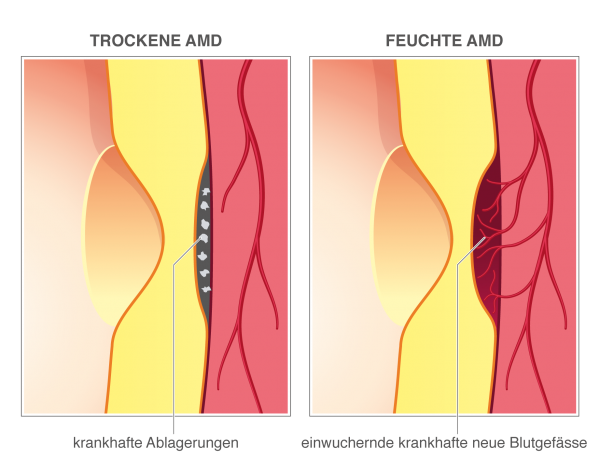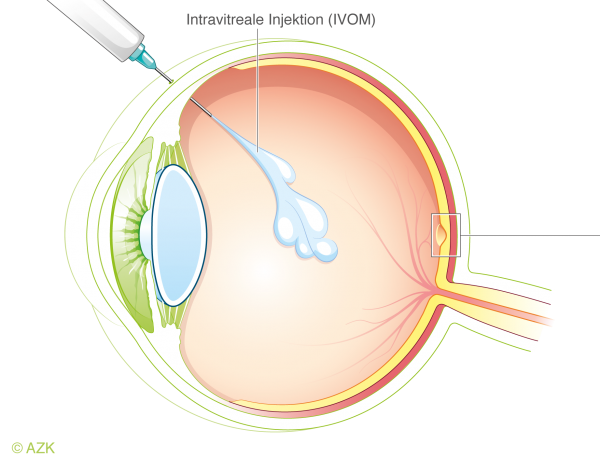Treatments
Treatments
On the retina, the macula – the point with the sharpest vision – is the area with the largest density of photoreceptor cells. In the case of age-related macular degeneration (AMD), the function of photoreceptor cells is increasingly impaired, and they slowly die. Fundamentally, a distinction is made between wet and dry macular degeneration.
Macular degeneration is a condition that usually occurs in old age. It is by far the most common cause of poor vision in the West. It generally occurs as a constitutional result of old age, but smoking and high blood pressure, for example, are also common risk factors.
With a dry macula, superfluous metabolic products are no longer broken down completely and are stored in the form of a globular accumulation (drusen) under the retina. Here, they block the supply of nutrients to the photoreceptor cells and thereby increasingly impair eyesight – for example, blurred vision or severely restricted, insular blind spots.
With a wet macula, fine new blood vessels quickly form that crowd the macula (yellow spot). Liquid or even blood can escape from these vessels and destroy the delicate sensory cells.

As with glaucoma, the symptoms of macular degeneration are often detected late. The result is a slow decrease in visual acuity, reduced ability to read and distorted vision.
During the check-up, central visual acuity is measured. Examination with the Amsler grid is a very significant test. If the grid lines on the paper do not appear straight for the patient, but distorted, this is a clear indication of macular degeneration.

In the case of dry age-related macular degeneration, progression of the disease can be slowed by dietary supplements with high doses of vitamin C and E, beta carotene and zinc, along with lutein supplements.
The wet macula is treated by so-called IVOM therapy (medication delivered via intravitreal injection). The medication is thereby injected directly into the vitreous body of the eye. The treatment is painless thanks to anaesthetic drops. The growth of the abnormal vessels is suppressed and eyesight stabilises again over time.
Intravitreal injection means ‘into the vitreous body’. This treatment method involves medication being injected directly into the eye or the vitreous body. In wet macular degeneration, it leads to an improvement in eyesight thanks to the drying of the tissue. Further application areas are macular conditions as a result of metabolic disorders or circulatory impairment.
Medication in the form of tablets, infusions or eye drops can only be used to a limited extent at the back portion of the eye in the case of certain conditions, or they cannot take effect there in sufficient concentrations. The ophthalmologist must therefore inject the medication directly into the eye. The procedure is carried out on an outpatient basis and is painless.

Contact
Augenzentrum Kiener AG
Mellingerstrasse 207
5405 Baden-Dättwil
Opening hours
MO bis FR: 8:00 – 12:00 am, 1:00 – 5:00 pm
SA: by arrangement
You will find the Kiener Augenzentrum on the 1st floor of the Täfernhof Medical Center (Täfernhof 1).